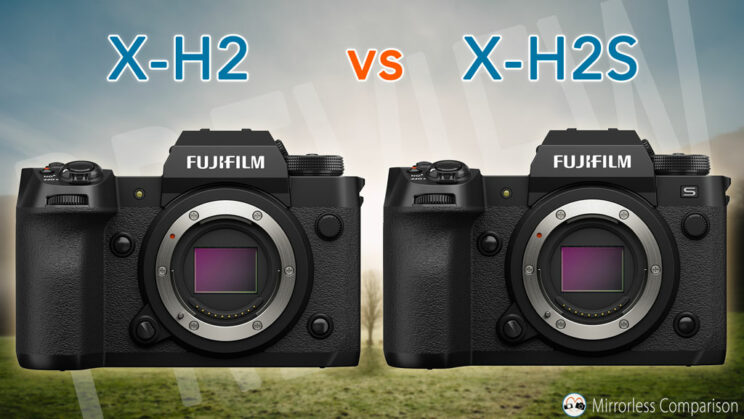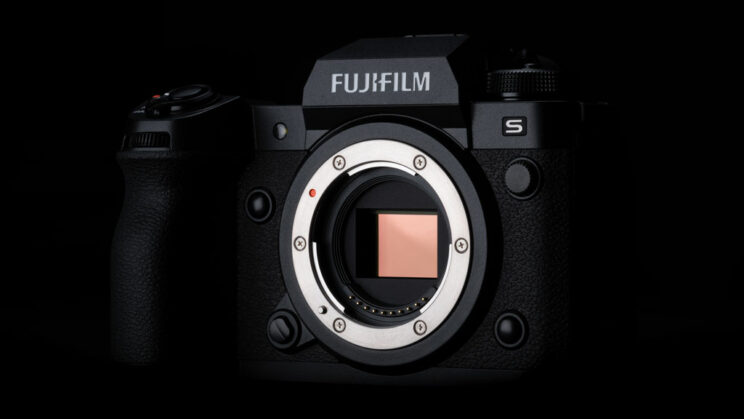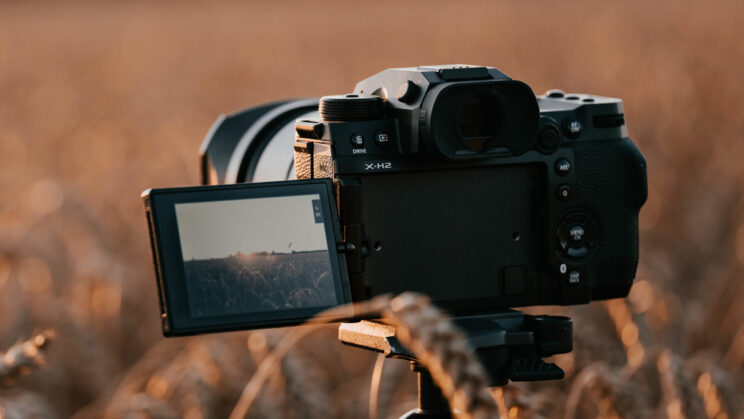Fujifilm has announced the X-H2, a camera that sets a new record with the highest resolution seen on a APS-C sensor (40MP), breaking the previous record from Canon with its 32MP sensor (90D and M6 II). But that’s not all the new Fujifilm model has to offer.
It can record 8K video with a great choice of codecs, including Apple Prores, inherits the latest autofocus system with intelligent subject detection, and much more.
The X-H2S is equally impressive, and actually the two cameras are identical on the outside, in addition to sharing many features and technology. So before we dive into the 5 main differences, here is a recap of the many things the two share.
What the X-H2 and X-H2S share in common:
- Body design with weather-sealing (136.3 x 92.9 x 84.6mm, 660g)
- OLED viewfinder with 5.76M dots, 0.8x magnification, 120fps, 24mm eyepoint
- Multi-angle LCD screen with 1.62M dots and touch control
- Hybrid AF system with 117/425 points, -7EV (F1.0), Subject Detection (animals, birds etc.)
- 5-axis in-body image stabilisation (up to 7 stops, depending on the lens)
- Microphone input, headphone output (3.5mm jack)
- Full size HDMI port
- 10Gbps USB-C
- NP-W235 battery with very similar rating

Ethics statement: the following is based on official specifications. We were not asked to write anything about these products, nor were we provided any compensation of any kind. Within the article, there are affiliate links. If you buy something after clicking one of these links, we will receive a small commission. To know more about our ethics, you can visit our full disclosure page. Thank you!
1. Sensor
The two cameras feature the latest X-Processor 5 engine and an APS-C sensor, but the specs of each are quite different.
First, the X-H2 has 40.2MP, whereas the X-H2S has 26.1MP.
Second, while both sensors have a BSI design (back-illuminated), that of the S model is also stacked and gives the camera more readout speed.

The ISO sensitivity remains very similar, with the only difference being the base level with the normal range.
Camera
Normal range
Extended range
X-H2
125 – 12,800
64 – 51,200
X-H2S
160 – 12,800
80 – 51,200
Both cameras can shoot RAW (uncompressed, lossless compressed and compressed) as well as JPG and 10-bit HEIF images. A Tiff option is also available with the in-camera RAW conversion.
2. Video recording
The high resolution on the sensor allows the X-H2 to record 8K up to 30p. You can also select 6.2K video up to 30p. In 4K, you can work up to 30p with oversampling from 8K, or up to 60p with sub-sampling. In Full HD, the frame rate goes up to 240p with the High Speed mode.

The X-H2S doesn’t reach 8K, but it’s no less capable by any means: it can record 6.2K 30p in the 3:2 aspect ratio (open gate), as well as 4K 120p (with a 1.29x sensor crop).
Both cameras offer a lot of codecs, including H.265 and Apple Prores. You can record 10-bit 4:2:2 internally, or 12-bit RAW via HDMI and a compatible recorder (optional).
Neither camera has the 30min recording limitation, and if you want piece of mind about overheating, there is an optional cooling fan you can attach to the back of the camera.
Here are all the most important specifications.
VIDEO
X-H2
X-H2S
8K
30p
–
6.2K
30p
30p
4K
60p
120p
Full HD
240p
240p
Bit depth
10-bit 4:2:2
10-bit 4:2:2
Codec
Prores
H.265
H.264
Prores
H.265
H.264
Max. Bitrate
730M
730M
RAW
HDMI*
HDMI*
Profiles
F-Log
F-Log2
HLG
F-Log
F-Log2
HLG
*Note: To record RAW video via the HDMI port, you need an optional external recorder such as the Atomos Ninja V.
3. Speed
The X-H2 can take pictures up to 15fps when using the mechanical shutter, which is the same speed found on the X-H2S and the X-T4. But with the electronic shutter, things are different.
Thanks to its stacked sensor design, the X-H2S offers a superior drive speed, up to 40fps. Full AF and AE tracking is maintained, and there is no sensor crop or other limitations.
The X-H2 does a respectable 20fps, but only with a 1.29x crop on the sensor, which gives you a file of 24MP.

Concerning the buffer, the X-H2 offers similar performance to the S model which is surprising, especially 15fps at which it uses the full 40MP.
Buffer
X-H2
X-H2S
15fps
1000+ JPG
1000+ RAW
1000+ JPG
1000+ RAW
20fps
1000+ JPG
1000+ RAW
1000+ JPG
1000+ RAW
30fps
–
1000+ JPG
270 RAW
40fps
–
184 JPG
175 RAW
Note: the data shown is for compressed RAW and when using a CFexpress card.
One impressive specification found only on the X-H2 is the possibility of using a shutter speed as fast as 1/180,000s (with the electronic shutter) thanks to what Fujifilm calls a special drive system. By comparison, the S model goes up to 1/32,000s.
4. Pixel Shift Multi Shot
For the first time on a Fuji X-series camera, you can composite multiple shots to create more resolution.
The X-H2 captures 20 images in a row, moving the sensor by half a pixel in between. With the Pixel Shift Combiner software, you can the composite these 20 images to create a DNG file with 160MP.
As always, this will work best with the camera on a tripod, and no movements inside your scene.
5. Price
The X-H2 is less expensive, with a retail price of $2000 or £1900.
The X-H2S can be found at $2500, £2500 or €2750.
Note that these prices are for the body only, as of September 2022.
The X-H2 offers a substantial boost in image resolution, more than any previous Fujifilm camera, but does so without compromising the performance too much, at least on paper.
The S model has the upper hand in terms of continuous shooting speed, but the X-H2 offers most of the same impressive video specs (minus 4K 120p), the same AF system and the same exact body design. And then there is that impressive shutter speed of 1/180,000s.
I don’t think it’s going to be easy to choose between these two cameras. Wildlife photographers will like the idea of a 40MP sensor, but also the 40fps burst of the S model. Video makers will wonder if it’s better to have 8K or 4K 120p. For most, the choice will be in the details.
But for everybody else, the 40MP sensor might be tempting enough, as well as the lower price of the camera compared to the X-H2S.
Reminder: the links below are affiliate links. If you decided to buy something after clicking the link, we will receive a small commission.
Check price of the Fujifilm X-H2 on
Amazon | B&H Photo
Check price of the Fujifilm X-H2S on
Amazon | Amazon UK | B&H Photo


